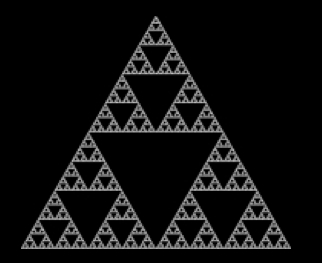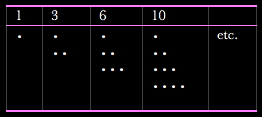chaos game (for nancarrow)
Chaos Game (For Nancarrow) is a musical implementation of the triangular version of Barnsley’s well-known chaos game algorithm (Barnsley 2000). Mathematician Michael Barnsley coined the term to refer to a process by which a fractal image is generated on a computer screen using randomly chosen points. The work is a musical fractal whose fabric is woven by mapping the points on the screen to notes that are heard in real time.
A fractal is a self-similar geometrical object, that is to say, the same object appears on many scales. For example, the Sierpinski sieve (also called the Sierpinski triangle) shown in Fig. 1 is a fractal made up of triangles on all scales.

Fig. 1. The Sierpinski sieve.
Each dot in this fractal is mapped to a pitch as it is drawn on the screen. The algorithm that draws the sieve and generates the pitches is given in Fig. 2.
| Step 1: | An equilateral triangle is defined on the computer screen and a random dot is chosen as an arbitrary starting point. |
| Step 2: | One of the three vertices of the triangle is chosen at random and the next dot is drawn half way between the previous dot's position and the randomly chosen vertex. |
| Step 3: | Repeat Step 2 hundreds of times. |
| Step 4: | Stop when a fractal of sufficient detail emerges on the computer screen. |
Fig. 2. The chaos game algorithm.
Because the pitch selections are essentially random, every performance of the work is quite different at the level of the musical surface. At higher levels of structure, however, scale sieves and other boundary conditions constrain the random number selections in ways that provide the listener with a familiar sense of harmonic direction across multiple performances. The surface detail of this fractal-music tapestry is created by two-voice deceleration canons, a Nancarrow-inspired micropolyphonic technique that features a shifting, rather than constant, time interval between two canonic voices (Gann 1995). This shifting time relationship creates a sense of curved time between the canonic voices, a musical analogue of a tessellation process that, at times, produces paradoxical resultant patterns.
In keeping with the triangular theme, all of the rhythmic parameters were derived from the triangular number sequence (Fig. 3).
1, 3, 6, 10, 15, 21, 28, 36, 45, 55, 66, 78, 91, 105, 120, ...
Fig. 3. The triangular number sequence.
Perhaps the simplest way to think of a triangular number is as the number of dots required to represent a triangle. The first four triangular numbers are shown in Fig. 4.

Fig. 4. Geometric representations of triangular numbers.
Triangular numbers have many interesting properties, many of which are reflected in the musical dimensions of this work. For example, triangular number proportions were used to determine: note duration, tempo, the number of notes in a gesture, the shifting time interval between canonic voices, and so on.
As shown in Fig. 5, the work is divided into three main sections defined by the presentation of three distinct fractals: Fractal I, Fractal II, and Fractal III.

Fig. 5. Tempo plan for chaos game.
Again modeling triangular number proportions, colored dots are drawn at the perceived beat rate–a constant 1/15th-note pulse duration executed according to the tempo plan. Each fractal presents an algorithmic variation on the Sierpinski sieve (Fig. 1) that is projected onto a large video screen for the audience to see. Performed by a trio of networked laptop computers arranged on stage in an approximately equilateral triangle configuration, the three players–named Red (R), Green (G), and Blue (B)–battle in computer game-like fashion to interactively color the projected fractals.
RB
references
Barnsley, Michael, 2000. Fractals Everywhere, 2nd ed. New York: Morgan Kaufmann.
Gann, Kyle, 1995. The Music of Conlon Nancarrow. Cambridge: Cambridge University Press, pp.146-48.
Weisstein, Eric W., 2009. "Chaos Game." From MathWorld--A Wolfram Web Resource.
http://mathworld.wolfram.com/ChaosGame.html
______________. "Fractal." From MathWorld--A Wolfram Web Resource. http://mathworld.wolfram.com/Fractal.html
______________. "Random Number." From MathWorld--A Wolfram Web Resource.
http://mathworld.wolfram.com/RandomNumber.html
______________. "Sierpinski Sieve." From MathWorld--A Wolfram Web Resource.
http://mathworld.wolfram.com/SierpinskiSieve.html
______________. "Tessellation." From MathWorld--A Wolfram Web Resource
http://mathworld.wolfram.com/Tessellation.html
______________. "Triangular Number." From MathWorld--A Wolfram Web Resource. http://mathworld.wolfram.com/TriangularNumber.html
links
Bogomolny, Alexander. Sierpinski Chaos Game - a Java applet that allows the user to play the chaos game at any "tempo."
Updated: January 12, 2012